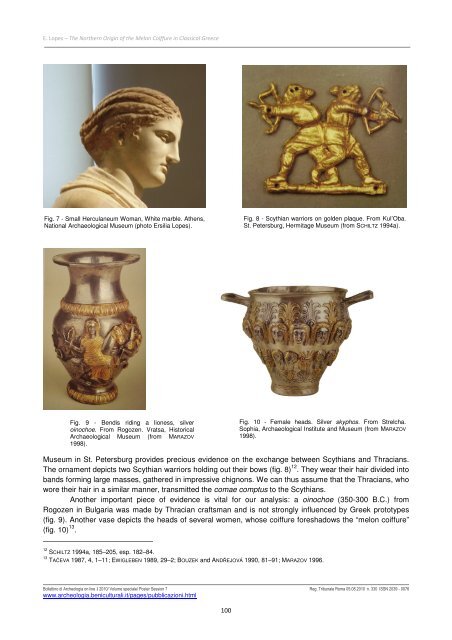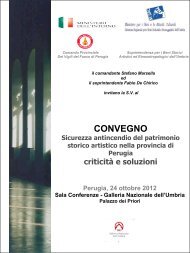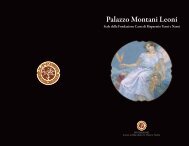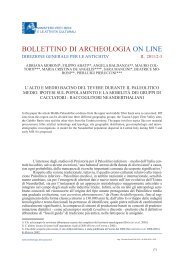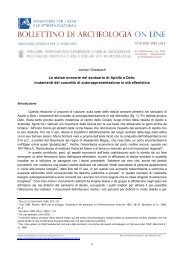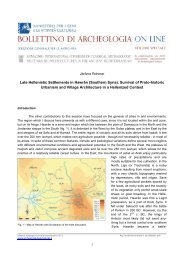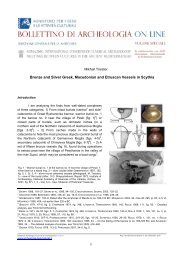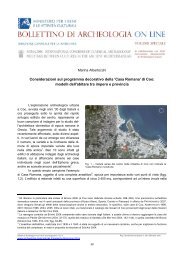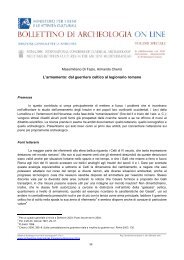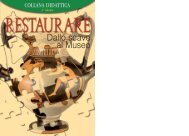The Northern Origin of the Melon Coiffure in Classical Greece
The Northern Origin of the Melon Coiffure in Classical Greece
The Northern Origin of the Melon Coiffure in Classical Greece
You also want an ePaper? Increase the reach of your titles
YUMPU automatically turns print PDFs into web optimized ePapers that Google loves.
E. Lopes – <strong>The</strong> <strong>Nor<strong>the</strong>rn</strong> <strong>Orig<strong>in</strong></strong> <strong>of</strong> <strong>the</strong> <strong>Melon</strong> <strong>Coiffure</strong> <strong>in</strong> <strong>Classical</strong> <strong>Greece</strong><br />
Fig. 7 - Small Herculaneum Woman, White marble. A<strong>the</strong>ns,<br />
National Archaeological Museum (photo Ersilia Lopes).<br />
Fig. 9 - Bendis rid<strong>in</strong>g a lioness, silver<br />
o<strong>in</strong>ochoe. From Rogozen. Vratsa, Historical<br />
Archaeological Museum (from MARAZOV<br />
1998).<br />
Bollett<strong>in</strong>o di Archeologia on l<strong>in</strong>e I 2010/ Volume speciale/ Poster Session 7 Reg. Tribunale Roma 05.08.2010 n. 330 ISSN 2039 - 0076<br />
www.archeologia.beniculturali.it/pages/pubblicazioni.html<br />
100<br />
Fig. 8 - Scythian warriors on golden plaque. From Kul’Oba.<br />
St. Petersburg, Hermitage Museum (from SCHILTZ 1994a).<br />
Fig. 10 - Female heads. Silver skyphos. From Strelcha.<br />
Sophia, Archaeological Institute and Museum (from MARAZOV<br />
1998).<br />
Museum <strong>in</strong> St. Petersburg provides precious evidence on <strong>the</strong> exchange between Scythians and Thracians.<br />
<strong>The</strong> ornament depicts two Scythian warriors hold<strong>in</strong>g out <strong>the</strong>ir bows (fig. 8) 12 . <strong>The</strong>y wear <strong>the</strong>ir hair divided <strong>in</strong>to<br />
bands form<strong>in</strong>g large masses, ga<strong>the</strong>red <strong>in</strong> impressive chignons. We can thus assume that <strong>the</strong> Thracians, who<br />
wore <strong>the</strong>ir hair <strong>in</strong> a similar manner, transmitted <strong>the</strong> comae comptus to <strong>the</strong> Scythians.<br />
Ano<strong>the</strong>r important piece <strong>of</strong> evidence is vital for our analysis: a o<strong>in</strong>ochoe (350-300 B.C.) from<br />
Rogozen <strong>in</strong> Bulgaria was made by Thracian craftsman and is not strongly <strong>in</strong>fluenced by Greek prototypes<br />
(fig. 9). Ano<strong>the</strong>r vase depicts <strong>the</strong> heads <strong>of</strong> several women, whose coiffure foreshadows <strong>the</strong> “melon coiffure”<br />
(fig. 10) 13 .<br />
12 SCHILTZ 1994a, 185–205, esp. 182–84.<br />
13 TAČEVA 1987, 4, 1–11; EWIGLEBEN 1989, 29–2; BOUZEK and ANDŘEJOVÁ 1990, 81–91; MARAZOV 1996.


